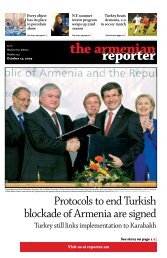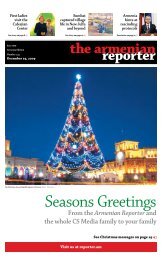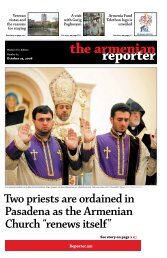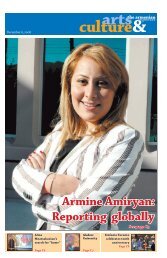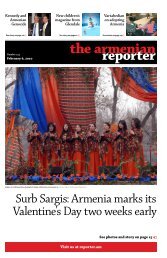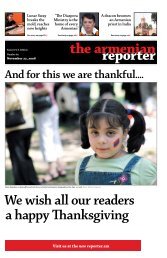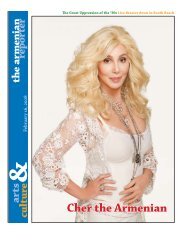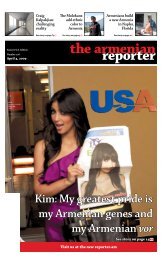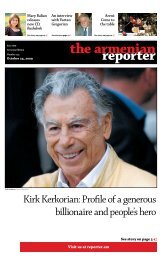Create successful ePaper yourself
Turn your PDF publications into a flip-book with our unique Google optimized e-Paper software.
February 21, 2009<br />
arts<br />
culture<br />
the armenian<br />
&<br />
reporter<br />
<strong>Inga</strong> & <strong>Anush</strong><br />
On their way to Eurovision 2009<br />
See page C3<br />
Sisters <strong>Inga</strong> and <strong>Anush</strong> Arshakyan performing at the Karen Demirchyan Sport and Concert Complex. Photo: Photolure.
Nigoghos Sarafian’s definition of wealth<br />
by Lory<br />
Bedikian<br />
The economy, here in the U.S. and around<br />
the world, has been on everyone’s mind<br />
for quite some time. We hear phrases<br />
such as “recession,” we hear about or experience<br />
the loss of homes to foreclosures,<br />
the loss of jobs, and we listen to the news<br />
to see if there is any hope in sight.<br />
Money issues may be in the forefront<br />
for the general population of<br />
this country now, but they have been<br />
an ongoing struggle for others across<br />
the globe for generations. Sometimes<br />
I think about the fact that suddenly<br />
we hear so much about the amount of<br />
losses and all their repercussions, but<br />
other populations in other countries<br />
are probably thinking that it’s nothing<br />
new to them.<br />
I have to admit I don’t know much<br />
about economics. I only know that poverty<br />
upsets me, and need saddens me.<br />
Sometimes I have to put my surroundings<br />
on hold and really think about my<br />
own riches, whether they reside in poems,<br />
or just in the fact that I was able to<br />
have three meals in one day.<br />
Everyone has their own definition of<br />
abundance and each person has their<br />
own way of determining what they are<br />
blessed with. Since money – or the lack<br />
of it – has been on the minds of so many<br />
of us, I’ve been looking for poems that<br />
may touch upon this subject. I found a<br />
few about money or suffering and much<br />
of what we can expect, but it was a poem<br />
by Nigoghos Sarafian that caught my attention.<br />
Sarafian writes a poem, “Wealth,” and<br />
although the title suggests riches in<br />
monetary or material terms, we see that<br />
the speaker has something completely<br />
different in mind.<br />
Wealth<br />
My wealth is a heap of unexplainable sad<br />
moments.<br />
From this yellow trash my arteries branch<br />
and blossom out.<br />
In the spring, the cherry trees rise like<br />
a fakir to dispense talismans with shivering<br />
hands.<br />
Moments. Between life and death are moments,<br />
only,<br />
Lory Bedikian received her MFA in Poetry from<br />
the University of Oregon. Her collection of<br />
poetry has twice been selected as a finalist in<br />
the Crab Orchard Series in Poetry Open Competition<br />
and twice in the Crab Orchard Series<br />
in Poetry First Book Award Competition.<br />
<strong>Armenian</strong> <strong>Reporter</strong> Arts & Culture<br />
Copyright © 2009 by <strong>Armenian</strong> <strong>Reporter</strong> llc<br />
All Rights Reserved<br />
Contact arts@reporter.am with announcements<br />
To advertise, write business@reporter.am or<br />
call 1-201-226-1995<br />
which face each other fiercely over a game<br />
of chess.<br />
Moments like sudden flashes of lightning<br />
that could work miracles if they could be<br />
held.<br />
I dance a thousand jigs like a marionette<br />
soldier.<br />
Without the cord, I become again the awkward<br />
peasant.<br />
I was an angel distributing children’s presents.<br />
Christmas passed and I turned back into a<br />
tree.<br />
My sad unexplainable moments are my<br />
wealth.<br />
And from this yellow trash heap my arteries<br />
stem and bloom.<br />
Sarafian – who was born on a ship<br />
traveling to Bulgaria from Istanbul – authored<br />
four books, lived from 1905 to<br />
1973, and wrote “Wealth” in 1927. Perhaps<br />
it is comforting to know that this<br />
poet, decades ago, also felt that wealth<br />
was not attainable and that his source of<br />
prosperity was in his “sad unexplainable<br />
moments.”<br />
by Shahane Martirosyan<br />
GLENDALE – It’s not often that lectures<br />
on the classics of <strong>Armenian</strong> literature<br />
focus on sex and sexual relations.<br />
Thus, it was a particularly interesting<br />
evening at Glendale Public Library on<br />
January 31, when Professor Krikor<br />
Beledian delivered a lecture about Levon<br />
Shant’s The Woman, concentrating<br />
on the sexual connotations present in<br />
the novelette.<br />
Professor Beledian, who teaches<br />
<strong>Armenian</strong> studies at the Université<br />
Catholique de Lyon and the Institut<br />
national de langues et civilisations orientales<br />
in Paris, is a leading figure in<br />
<strong>Armenian</strong> letters.<br />
The lecture was organized by the<br />
Hamazkayin Western Region Committee<br />
and the Glendale Public Library<br />
and was titled, “The Artist and<br />
His Model: Analysis of Levon Shant’s<br />
Literary Work.” The event brought together<br />
<strong>Armenian</strong> scholars, professors,<br />
and literature lovers for a very unusual<br />
evening.<br />
The Woman is about a painter living<br />
in Munich and a woman he meets at<br />
the opera. She agrees to sit for a painting.<br />
After the painting is completed, she<br />
rips it up in the painter’s bedroom and<br />
leaves him. He goes to look for her in<br />
her hometown. He never finds her. He<br />
patches the painting back together and<br />
presents it as an exhibit with the title<br />
“The Woman.”<br />
The scene in the book when the woman<br />
goes into the painter’s bedroom is<br />
symbolic, for it suggests that the painter<br />
and the model had made love. In<br />
Shant’s illustration, the room has a fire<br />
What resonates so much in this piece<br />
is Sarafian’s imaginative writing. Yes,<br />
he uses the traditional device of repetition<br />
when reiterating the lines regarding<br />
“wealth,” “moments,” and “yellow<br />
trash,” but his craft goes further than<br />
that. The “yellow trash” is a metaphor<br />
for the speaker’s sad moments. He<br />
then doubles his use of metaphors by<br />
telling the reader that the speaker’s<br />
“arteries branch and blossom out.” At<br />
the end of the poem, this moment is<br />
extended when Sarafian’s speaker tells<br />
us “Christmas passed and I turned<br />
back into a tree.” He never calls himself<br />
a tree before that, but merely suggests<br />
it with “branch” and “blossom.”<br />
At the close of the poem, he further<br />
enriches the metaphor with “stem”<br />
and “bloom.”<br />
The spiritual elements of this poem exist<br />
not in the use of traditional phrases<br />
or symbols, but in the poet’s references<br />
to nature and other words. For example,<br />
Sarafian refers to the “fakir” – in this instance<br />
I believe he is suggesting the Sufi<br />
miracle-maker who can walk on burning<br />
coals without a sound. Sarafian uses a<br />
simile to depict that “the cherry trees<br />
rise like / a fakir to dispense talismans.”<br />
Referring to “miracles” and “an angel”<br />
in the background, a fully made table,<br />
and a bed. The woman places a wreath<br />
on the painter’s head. All of these objects<br />
represent marriage and sexual<br />
relations between the two characters,<br />
Beledian argued.<br />
Beledian reviewed the views of other<br />
literary critics about the novelette:<br />
the great literary critic Hagop Oshagan,<br />
as well as Krikor Shahinian and<br />
Nichol Akhbarian.<br />
According to Beledian, Oshagan was<br />
not a big fan of Levon Shant’s. Oshagan<br />
criticized Shant’s The Woman as<br />
little more than a love story between<br />
an artist and his lover, in which the<br />
protagonists do not complete their<br />
love story.<br />
Krikor Shahinian found that a woman<br />
cannot be whole on her own; she<br />
needs a man to complete her. Nichol<br />
Akhbarian, according to Beledian, had<br />
a preconceived notion regarding the relations<br />
between men and women; for<br />
him, men create art and women inspire<br />
art. He also believed that the characters<br />
in the novelette were not real, but fictitious.<br />
Looking at the novel from the<br />
takes the spiritual realm of the poem<br />
even further.<br />
Sarafian’s imaginative writing resonates<br />
also in several other instances.<br />
For example, he personifies moments<br />
“which face each other fiercely over a<br />
game of chess.” The speaker becomes a<br />
“marionette soldier” and then an “awkward<br />
peasant.” Each line of the poem<br />
holds one of several devices: a simile, a<br />
metaphor, a moment of personification,<br />
or repetition. In its native language I’m<br />
sure there are particular layers of rhythm<br />
and sound. In other words – and excuse<br />
the pun – Sarafian has used a wealth of<br />
devices in a short, but effective poem.<br />
Some may say it’s discouraging to recognize<br />
one’s own wealth in sad moments,<br />
but we shouldn’t forget that out of these<br />
moments, the speaker of Sarafian’s poem<br />
becomes a healthy tree. Of course, I do<br />
wish for all of us to have happier moments.<br />
After all, it wouldn’t hurt to have<br />
all types of abundance, all types of wealth,<br />
and from all of it, to be able to flourish<br />
and bloom.<br />
f<br />
“Wealth” from Anthology of <strong>Armenian</strong> Poetry, translated<br />
by Diana Der-Hovanessian, edited by Diana Der-<br />
Hovanessian and Marzbed Margossian, Columbia<br />
University Press, 1978. Reprinted with permission.<br />
Krikor Beledian discusses sexual relations in Levon Shant’s The Woman<br />
Krikor Beledian.<br />
painter’s point of view, Akhbarian saw<br />
sex as a threat to art.<br />
Beledian maintained that these critics<br />
never addressed the woman’s cutting<br />
the painting as a sexual act, which<br />
just happens to be the climax of the<br />
novel.<br />
When the woman is in the painter’s<br />
room – Suren’s room – the author tries<br />
to convey that the woman tells the<br />
painter that she loves him. In return,<br />
Suren tells her that he loves her as a<br />
muse. This is when the woman rips<br />
the painting with a knife. During their<br />
conversation, the painter speaks of<br />
their relationship in the past tense as<br />
if their relationship had ended. Beledian<br />
also argued that if the woman<br />
had not cut the painting, the painting<br />
would not be real. When the woman<br />
cut it, she justified the fact that the<br />
painting was real. “The painting did<br />
not really exist until it was ripped,”<br />
Beledian stated.<br />
In a sense, for Shant, by ripping the<br />
painting, the woman took the painting’s<br />
spirit out and created a work<br />
of art. This scene reached into the<br />
woman’s personality and brought it<br />
out. Here the painting finds its own<br />
identity when the woman leaves the<br />
room, leaving the painter alone with<br />
his work. The painting’s full independence<br />
is achieved when it is displayed<br />
at the exhibition.<br />
At the conclusion of his lecture, Beledian<br />
took questions from the audience,<br />
which included comedian Vahe Berberian,<br />
president of the American University<br />
of Armenia Haroutune <strong>Armenian</strong>,<br />
and <strong>Armenian</strong> language lecturers from<br />
UCLA Anahid Keshishian and Hagop<br />
Kouloujian.<br />
f<br />
C2 <strong>Armenian</strong> <strong>Reporter</strong> Arts & Culture February 21, 2009
Sisters <strong>Inga</strong> and <strong>Anush</strong><br />
Arshakyan performing<br />
at the Karen<br />
Demirchyan Sport<br />
and Concert Complex.<br />
Photos: Photolure.<br />
<strong>Inga</strong> & <strong>Anush</strong> to represent Armenia at the<br />
Eurovision 2009 Song Contest with “Jan Jan”<br />
by Nyree<br />
Abrahamian<br />
Yerevan – Backstage at the Karen<br />
Demirchyan Sport and Concert Complex<br />
last Saturday night, it was all nerves, vocal<br />
exercises, and make-up. The 21 finalists<br />
vying for the top spot to represent Armenia<br />
in Moscow, at the Eurovision 2009<br />
Song Contest, were getting ready for the<br />
concert that could potentially boost their<br />
careers to the international scene.<br />
Armenia has been participating in<br />
Eurovision since 2006, but this was the<br />
first year that so many finalists were<br />
considered. They represented a broad<br />
range of genres from rock (The Bambir,<br />
Dorians) to <strong>Armenian</strong> hip hop (Davo),<br />
and everything in between.<br />
Early favorites among this year’s finalists<br />
included Shprot, a bubbly blonde pop<br />
singer who pulled off a risqué half-man/<br />
half-woman act [see last week’s Arts &<br />
Culture section for a profile], Mher, who,<br />
hailing from Moscow, has a growing fan<br />
base in Armenia and in the large diaspora<br />
community in Russia, and <strong>Inga</strong> &<br />
<strong>Anush</strong>, a duo of sisters with beautiful<br />
voices and a funky, modern twist on traditional<br />
<strong>Armenian</strong> folk music.<br />
In the end, it was <strong>Inga</strong> & <strong>Anush</strong> who<br />
took it with their surprisingly popinspired<br />
song, “Jan Jan.” “It’s a style that<br />
we call folk pop,” said an ecstatic <strong>Anush</strong><br />
after the show, “And you’ll notice that<br />
most successful artists everywhere in<br />
the world are being noticed and creating<br />
hits with fusion styles.”<br />
Though <strong>Inga</strong> & <strong>Anush</strong> had not revealed<br />
their song before Saturday night’s performance,<br />
word on the street (and all<br />
over youtube.com) was that the song<br />
<strong>Inga</strong> Arshakyan.<br />
<strong>Anush</strong> Arshakyan.<br />
they had selected was “Gutan,” a strong<br />
folk rock song with an edgy video. <strong>Inga</strong><br />
even hinted at a press conference a few<br />
days before the concert that their main<br />
focus lately had been experimenting<br />
with folk rock. But in the end, probably<br />
since Eurovision is a mainly pop-based<br />
competition, “Jan, Jan,” the catchier option<br />
with a combination of English and<br />
<strong>Armenian</strong> lyrics, won out. “We are not<br />
betraying our roots. We are staying true<br />
to our style and growing in our musical<br />
experimentation,” said <strong>Anush</strong>.<br />
Although <strong>Inga</strong> & <strong>Anush</strong> were clearly an<br />
audience favorite, there were a lot of questions<br />
and speculation regarding how exactly<br />
the winner was chosen. The idea was<br />
that the winner would be selected through<br />
a combination of audience votes via text<br />
messaging, and a panel of judges, each<br />
weighted equally. But it was disappointing<br />
that the identity of the judges was never<br />
revealed, and it wasn’t quite clear how audience<br />
votes and the judges’ evaluations<br />
could be weighed on the same scale.<br />
Mher, whose ultra-catchy song, “I<br />
Love You” (bound to be a club favorite<br />
this summer in Armenia and Russia)<br />
came in second, was clearly disappointed<br />
but gracious after the show. Asked<br />
if he thought the result was fair, he responded,<br />
“To be honest, I don’t know<br />
what the breakdown was between audience<br />
votes and the jury. They don’t<br />
tell us that. And I know a lot of people<br />
had trouble getting their text messages<br />
through.... But I should hope that everything<br />
was conducted in a fair and<br />
just fashion. What’s important is that<br />
<strong>Inga</strong> & <strong>Anush</strong> represent us well at Eurovision.<br />
I like their song and I wish<br />
them well.”<br />
The Eurovision Song Contest is a tradition<br />
that is over 50 years old, and<br />
every year, its popularity seems to be<br />
growing around the world. It is broadcast<br />
not only in Europe, but everywhere<br />
from the United States to Hong Kong.<br />
Since 2006, it is even broadcast online.<br />
Eurovision is one of the most-watched<br />
non-sporting events in the world, with<br />
audience figures in recent years quoted<br />
as anything between 100 million and<br />
600 million internationally. Last year,<br />
Armenia was represented by Sirusho,<br />
whose song, “Qele, Qele” came in fourth<br />
place and was subsequently a huge hit,<br />
blared all through the summer on radio<br />
stations throughout Europe.<br />
Best of luck to <strong>Inga</strong> & <strong>Anush</strong> at Eurovision<br />
2009! Watch for it in May. f<br />
<strong>Armenian</strong> <strong>Reporter</strong> Arts & Culture February 21, 2009<br />
C3
Hakob Hakobyan: repatriate, patriot, painter<br />
Discovering new forms<br />
of expression in an<br />
unfamiliar time<br />
by Maria<br />
Titizian<br />
YEREVAN – When I asked a friend of<br />
mine, well versed in all things artistic and<br />
articulate, if there was anything I should<br />
know before interviewing the renowned<br />
artist Hakob Hakboyan, he said: “Hakob’s<br />
main characteristic is that he is the<br />
conveyor of the eternal pain of Armenia.<br />
The Genocide is permanently imprinted<br />
on his essence as a man.”<br />
Riding up the elevator to the 10th<br />
floor of his apartment building in Yerevan,<br />
I tried to form images in my head of<br />
this Western <strong>Armenian</strong> painter who had<br />
come of his own volition to Soviet Armenia<br />
in the 1960s. Would he be candid<br />
Was he bitter Did his art suffer because<br />
of his desire to move to an elusive notion<br />
of homeland Did his nationality,<br />
his history dictate his path in life as an<br />
artist Did it make him a better artist<br />
He opened the door to his spacious<br />
apartment/studio and welcomed me in,<br />
quickly escorting me through a maze of<br />
rooms and corridors to his sitting room.<br />
Once we settled in and had spoken for a<br />
few minutes, I realized that after 47<br />
years he had not lost his Western<br />
<strong>Armenian</strong>; in fact he had retained<br />
most of it and only a few Eastern <strong>Armenian</strong><br />
expressions and pronunciations<br />
made their way into his speech.<br />
Not only was he candid and unassuming,<br />
but he allowed me to travel<br />
with him back to his childhood, unlocking<br />
some of the pain and confusion<br />
of his early existence, which<br />
undoubtedly led him to become one<br />
of the greatest <strong>Armenian</strong> painters<br />
of our time.<br />
This is the story of Hakob Hakobyan.<br />
Fate, loss, destiny<br />
Hakob Hakobyan was born in Alexandria,<br />
Egypt, in 1923,<br />
the second of three<br />
children. His parents<br />
were from Aintab. I<br />
assumed that here his<br />
story would take the<br />
traditional narrative:<br />
parents forced on to<br />
deportations, barely escaping, make their<br />
way to Egypt. But fate had saved them<br />
from the tragedy that befell so many. “We<br />
were lucky. Only some members of our<br />
family were forced on deportation routes<br />
and then killed. The rest had left before<br />
the Genocide,” he said.<br />
At the time of the 1896 massacres,<br />
Hakobyan’s father, 15 years old at the<br />
Hakob Hakobyan in his studio in Yerevan. Photos: Grigor Hakobyan for the <strong>Armenian</strong> <strong>Reporter</strong>.<br />
time, was sent to the United States by<br />
his family to live with his married sister.<br />
“We don’t know much about our father<br />
because we lost him at a very young age,”<br />
Hakobyan said. All they know is that<br />
he stayed in the United States for 18<br />
years before moving to Egypt sometime<br />
in 1913. “In the meantime, my mother’s<br />
father had moved to Alexandria also before<br />
the Genocide. My grandfather then<br />
returned to Aintab to bring the rest of<br />
his family, but they were killed before he<br />
got there. My mother and father then<br />
were spared of the Genocide.”<br />
After losing his father at the<br />
age of seven, Hakobyan was<br />
sent Melkonian Educational<br />
Institution in Cyprus to continue<br />
his education. “I guess they<br />
sent me away to school so that<br />
I wouldn’t be left on the streets,<br />
and to receive an education. I<br />
wasn’t able to continue my education<br />
because of the war. That’s<br />
how my life progressed – with<br />
different waves. I really never<br />
had a plan,” he explained.<br />
The joy of revelation<br />
One day Hakobyan’s father took<br />
him in his lap and drew a rabbit<br />
on a piece of paper.<br />
“For me it was<br />
like witnessing<br />
a<br />
miracle. I<br />
had never<br />
seen<br />
a n y o n e<br />
draw before. My father asked me if I<br />
could draw one. I tried and I was able to<br />
draw the rabbit. After that I always drew,”<br />
he said plaintively. He admits to loving<br />
the attention he would get every time<br />
he drew. “As a child when I would draw<br />
people would compliment my drawings.<br />
I guess in a way it was very psychological.<br />
When people compliment you, you then<br />
want to receive those compliments, so<br />
you draw.”<br />
His first art teachers who had a great<br />
influence on the young student while at<br />
Melkonian were Arakel Badrig and Onnik<br />
Avedisian. However his tenure at<br />
Melkonian was short-lived and he was<br />
forced to return to Egypt in 1941 because<br />
of the Second World War.<br />
“Life was difficult. I was forced<br />
to work. It’s<br />
very dangerous<br />
to<br />
stop something<br />
halfway<br />
through,” he<br />
said, referring to<br />
his education, which he<br />
never was able to return to. “I always<br />
lived in uncertainty. Everything was<br />
in disarray, unorganized. Even my<br />
painting was unorganized,” he admited.<br />
But his love of<br />
reading <strong>Armenian</strong><br />
literature and history<br />
sustained him<br />
through those difficult<br />
years.<br />
In 1952 he traveled to Paris. It was during<br />
his time there until 1954 that he decided<br />
not to abandon painting. “It was<br />
a very high ideal – to paint and support<br />
my family through my painting.”<br />
The journey “home”<br />
The yearning to move to Armenia started<br />
at a very young age for Hakobyan. “It<br />
was my destiny to move here,” he said.<br />
He hadn’t been able to come during the<br />
great repatriation of 1946–48 when over<br />
100,000 <strong>Armenian</strong>s from all over the<br />
world repatriated to Soviet Armenia. Even<br />
after hearing all the stories of how the repatriates<br />
had suffered, his desire to come<br />
to Armenia remained the guiding light of<br />
his life.<br />
He was finally able to repatriate in<br />
1962 with his wife Mari and their two<br />
young daughters, aged five and 11.<br />
He said that even after living here for<br />
more than 40 years,<br />
people still ask him<br />
why he came. “I always<br />
wanted to come to<br />
Armenia,” he put it simply.<br />
The fundamental desire for him<br />
was to live in the homeland and not<br />
in odarutyun. “There is and was only one<br />
Armenia. There wasn’t a capitalist Armenia<br />
or a Bolshevik Armenia. There was<br />
only one Armenia.<br />
At<br />
that time<br />
it happened to be under a communist<br />
system. Armenia is a much older thing<br />
than that regime it was under for 70 years<br />
– that regime disintegrated and disappeared<br />
but Armenia remained,” he said.<br />
Though he is softspoken, with kindly<br />
eyes, his tone shifted when he started<br />
talking about the Soviet regime<br />
and its lasting impact on<br />
the people of Armenia.<br />
“Whoever hasn’t lived<br />
under the Soviet regime<br />
can never understand<br />
what kind of a monstrous regime it was.<br />
A regime like that has never existed<br />
in the history of mankind. It was a regime<br />
that wiped out millions of people.<br />
Very few heroic people tried to struggle<br />
against it. They paid the price with their<br />
lives or were exiled. Look at how they<br />
killed Charents,” he said, as he became<br />
more animated.<br />
He admited that he wasn’t treated as<br />
badly as some, yet he could never escape<br />
the “nightmare” because of what he saw<br />
the Soviets do to other people. When he<br />
spoke about 1946, he didn’t mince his<br />
words. “The great repatriation was a disaster.<br />
Repatriation was the final, terrible<br />
blow to the Western <strong>Armenian</strong>s. What<br />
the Turks had left unfinished, the Soviet<br />
Continued on page C5 m<br />
C4 <strong>Armenian</strong> <strong>Reporter</strong> Arts & Culture February 21, 2009
n Continued from page C4<br />
Union completed. Those 100,000 people<br />
weren’t accepted as <strong>Armenian</strong>s, but as<br />
foreigners. After arriving they figured<br />
that out, but it was too late,” he told me.<br />
When I tried to broach the subject<br />
one more time, gently reminding him<br />
that the repatriates who came in the 40s<br />
must have contributed, at the very least<br />
through their way of life, through their<br />
cuisine and customs, something to the<br />
fabric of society , he said, “What good is<br />
it when you bring people in 1946–48 and<br />
then you exile them to Siberia in 1949<br />
If you didn’t want these people, if you<br />
brought them by mistake, why not just<br />
send them back where they came from<br />
Why do you exile them”<br />
There was more to his anger than appeared<br />
on the surface. He understood<br />
what the loss of homeland meant. More<br />
than that, he understood the hunger for<br />
returning. For him it was about their<br />
collective fate, their collective suffering,<br />
the Genocide that always hung over<br />
their heads. These feelings are portrayed<br />
in his paintings from that time period.<br />
With all that this artist has seen in his<br />
life, the one thing he doesn’t have is regret.<br />
“It was my destiny to move here, however.<br />
I have never regretted coming. I have never<br />
thought about leaving or living somewhere<br />
else. I always wanted to live in my<br />
country among my people,” he told me.<br />
His thoughts about repatriation today<br />
are ambiguous but of one conviction<br />
he is sure. “Repatriation today Don’t<br />
you think it would be better for them<br />
to find ways of hampering people from<br />
leaving the country” he asked. “The Diaspora<br />
Ministry should concern itself<br />
with finding ways of keeping people in<br />
the country, then trying to bring back<br />
those who left.”<br />
Starting over in Gyumri<br />
When the Hakobyan family repatriated<br />
to Armenia, they were settled in Gyumri,<br />
Armenia’s second largest city. They lived<br />
there for five years. Hakob was 40 years<br />
old. He was known in some artistic circles<br />
in Armenia already because he had<br />
donated 10 of his best paintings a few<br />
years earlier to the National Art Gallery.<br />
Life in Gyumri was difficult. “They<br />
didn’t even ‘give’ me a studio to paint,” he<br />
said. “Instead of all the accolades, if they<br />
had allowed me to have a small room to<br />
turn into a studio instead of working in a<br />
corner of my tiny apartment, that would<br />
have served me better.” He had brought<br />
some canvas with him when he moved,<br />
and after that was finished, he bought<br />
what he could find, which was of very<br />
poor quality. “A lot of my early paintings<br />
have been ruined because of that poor<br />
quality of canvas.” He still finds it ironic<br />
that they would only have poor quality<br />
canvas upon which paintings that were<br />
sometimes worth thousands of dollars<br />
would be painted. “Nothing made sense,”<br />
he said, shaking his head.<br />
“That’s how our life was in Gyumri. I<br />
don’t want to complain that I had to<br />
work under those conditions. For me the<br />
most important thing was to be able to<br />
paint in Armenia. I didn’t want to take a<br />
break. I didn’t want people think that I<br />
couldn’t succeed here,” he explained.<br />
After his first solo exhibition, he slowly<br />
began to establish himself as a painter<br />
in the homeland. Although even art was<br />
stifled under the Soviet regime, Hakobyan<br />
stressed that it wasn’t always possible to<br />
<strong>Armenian</strong> <strong>Reporter</strong> Arts & Culture February 21, 2009<br />
suffocate every human inspiration. “Look<br />
at Minas Avedissian. You can’t always take<br />
the art out of the man,” he told me, referring<br />
to a fellow artist.<br />
What would his life’s journey been<br />
had he not moved to Armenia “If I had<br />
stayed in Egypt, I might have become<br />
a different artist,” he said. The painter<br />
was also astute. He knew never to complain<br />
or demand in order to survive in<br />
the system. “I had no confrontations,<br />
but I retained my freedom in my sphere<br />
– through my art.”<br />
Thoughts about the nation<br />
“I have lived half my life outside of Armenia,<br />
then I lived under Soviet rule for<br />
27 years and 17 years in independence,”<br />
he said. He feels that we have suffered<br />
as a nation because of our size. “If we<br />
had been 30 million instead of 3 million,<br />
do you think that the Turks could have<br />
slaughtered us like sheep Therefore being<br />
a small nation is a sin,” he stressed.<br />
For Hakobyan there is an important<br />
distinction to be made. “Independence<br />
was given to us; we didn’t win it. For<br />
600 years we never had independence.<br />
Did we ever think about independence<br />
Therefore we never wanted it and now<br />
we don’t know what to do with it. We<br />
still want odars to come and govern us,”<br />
he told me. And about victories “Yes,<br />
we won in Karabakh. But look at what<br />
the price was – thousands dead, hundreds<br />
of thousands of displaced people,<br />
more than a million left the country.<br />
If this is victory, then bravo, we won,”<br />
he said, his voice straining. So there is<br />
some bitterness in this man’s spirit.<br />
And what about the state of the country<br />
today “After 600 years of slavery and<br />
survival, we have learned how to survive,<br />
but in the process we have become individualistic.<br />
We think only of taking care<br />
of ourselves. That is why we can’t move<br />
forward today. It’s all about the individual.<br />
There are no unifying elements.”<br />
He shifted in his chair and continued.<br />
“My dear, we don’t have normal relations<br />
with our neighbors. Two of them are our<br />
enemies; the neighbor to the north we<br />
want to turn into an enemy; the one<br />
to the south is the enemy of the rest of<br />
the world, and the other one [Russia],<br />
with whom we have no natural borders<br />
and who is our former ‘owner,’ is in our<br />
country protecting our borders.”<br />
His disenchantment causes waves of<br />
sadness to rush over him. He is frustrated<br />
because he is the first to admit that<br />
we are a nation of gifted people. “The <strong>Armenian</strong><br />
has limitless abilities. Before the<br />
Soviets, the <strong>Armenian</strong> was another sort<br />
of person, a totally different person,” he<br />
said. “We had genius; we had the farmer,<br />
but they turned him into a kolkhoznik;<br />
we had the artisan but they turned him<br />
into a laborer; and the entrepreneur was<br />
sentenced to exile or death. That is what<br />
the Soviet regime bequeathed us.”<br />
Studio visit<br />
Finding that our conversation had exhausted<br />
him, I suggested we move to his<br />
studio to look at his new creations. His<br />
demeanor changed, and the sadness and<br />
frustration subsided as he stepped into<br />
his oasis.<br />
As he walked around his studio, he<br />
told me that he works every day for a<br />
few hours. Today he produces about<br />
20–25 pieces annually. “I don’t have the<br />
same enthusiasm as I did, but creating<br />
something new still exists in me,” he<br />
said, pointing to shelves of newly created<br />
metal sculptures.<br />
Over the past year, Hakobyan has<br />
started creating sculptures out of scrap<br />
metal parts. “Every weekend I go to the<br />
Vernissage and buy these metal parts. After<br />
creating the sculpture I incorporate<br />
in into my paintings. I have made about<br />
Left: A collection of<br />
Hakobyan’s metal<br />
sculptures. Below: The<br />
story of Aryuts Mher<br />
is depicted in this stillto-be-named<br />
painting.<br />
100 sculptures this past year,” he said.<br />
A sculpture that appears to be two<br />
fish suspended on metal rods, proves,<br />
on closer inspection, to be two pincers<br />
used in jewelery making. “You are seeing<br />
this for the first time. I haven’t shown<br />
them yet,” he smiled. I feel privileged as<br />
I walk around the room, looking at the<br />
sculptures. When I asked him where he<br />
got the idea to create sculptures out of<br />
old metal parts, he said, “I don’t know.<br />
It just came to me.” Even at 87 years<br />
of age, this august painter still has fervent<br />
inspiration and creative drive. His<br />
paintings are still evolving. He has begun<br />
introducing not only his sculptures<br />
to his canvas, but also mannequins and<br />
gloves. If everything goes according to<br />
his plans, he intends to have an exhibition<br />
in April in Yerevan. He stops for a<br />
moment and then smiles: “It’s like an interesting<br />
game. When I put these metal<br />
pieces together, I feel as though I’ve become<br />
a child once again.” Perhaps this is<br />
the best time in Hakob Hakobyan’s life<br />
as he tries to recapture his lost childhood<br />
with new creations in an unfamiliar<br />
time.<br />
f<br />
C5
Program Grid<br />
23 February – 1 March<br />
EST PST<br />
10:00 PM 1:00 AM<br />
11:00 PM 2:00 AM<br />
11:30 PM 2:30 AM<br />
12:00 AM 3:00 AM<br />
1:00 AM 4:00 AM<br />
2:00 AM 5:00 AM<br />
2:30 AM 5:30 AM<br />
3:00 AM 6:00 AM<br />
3:30 AM 6:30 AM<br />
4:00 AM 7:00 AM<br />
4:30 AM 7:30 AM<br />
5:00 AM 8:00 AM<br />
5:30 AM 8:30 AM<br />
6:00 AM 9:00 AM<br />
6:30 AM 9:30 AM<br />
7:00 AM 10:00 AM<br />
7:30 AM 10:30 AM<br />
8:00 AM 11:00 AM<br />
8:30 AM 11:30 AM<br />
9:30 AM 12:30 PM<br />
10:00 AM 01:00 PM<br />
10:30 AM 01:30 AM<br />
11:00 AM 02:00 PM<br />
12:00 PM 03:00 PM<br />
12:30 PM 03:30 PM<br />
01:00 PM 04:00 PM<br />
01:30 PM 04:30 PM<br />
02:00 PM 05:00 PM<br />
02:30 PM 05:30 PM<br />
03:00 PM 06:00 PM<br />
03:30 AM 06:30 AM<br />
04:00 PM 07:00 PM<br />
04:30 AM 07:30 AM<br />
05:00 PM 08:00 PM<br />
05:30 PM 08:30 PM<br />
06:00 PM 09:00 PM<br />
06:30 PM 09:30 PM<br />
07:00 PM 10:00 PM<br />
07:30 PM 10:30 PM<br />
08:00 PM 11:00 PM<br />
08:30 PM 11:30 PM<br />
09:00 PM 12:00 AM<br />
09:30 PM 12:30 AM<br />
23 February 24 February 25 February 26 February 27 February 28 February<br />
Monday Tuesday Wednesday Thursday Friday Saturday<br />
Deal or No Deal<br />
Fathers & Sons<br />
Love E Lee<br />
7 Mekhq (Serial)<br />
TV Duel<br />
Tele Kitchen<br />
Mult<br />
Yo Yo<br />
News<br />
Bari Luys<br />
with Stepan Partamian<br />
Directions With<br />
Rafi Manoukian<br />
Bari Luys<br />
Hayer<br />
Bari Aravod<br />
News<br />
Yerkvoryak<br />
(Serial)<br />
7 Mekhq (Serial)<br />
Tele Kitchen<br />
Mult<br />
YO YO<br />
When Stars are Dancing<br />
Live from America<br />
News<br />
CLONE<br />
(Serial)<br />
Unlucky Happiness<br />
(Serial)<br />
Vrijarou<br />
(Serial)<br />
News<br />
Gyanki Keene<br />
(Serial)<br />
Tonight Show<br />
11 (Serial)<br />
News<br />
Bari Luys with Stepan<br />
Partamian<br />
CLONE (Serial)<br />
Vrijarou<br />
(Serial)<br />
Yerkvoryak (Serial)<br />
7 Mekhq (Serial)<br />
Unlucky Happiness<br />
(Serial)<br />
Tele Kitchen<br />
Mult<br />
Yo Yo<br />
News<br />
Bari Luys<br />
with Stepan Partamian<br />
Unlucky Happiness<br />
(Serial)<br />
Bari Luys<br />
Hayer<br />
Bari Aravod<br />
News<br />
Yerkvoryak<br />
(Serial)<br />
7 Mekhq (Serial)<br />
Tele Kitchen<br />
Mult<br />
YO YO<br />
When Stars are Dancing<br />
Live from America<br />
News<br />
CLONE<br />
(Serial)<br />
Unlucky Happiness<br />
(Serial)<br />
Vrijarou<br />
(Serial)<br />
News<br />
Gyanki Keene<br />
(Serial)<br />
Tonight Show<br />
11 (Serial)<br />
News<br />
Bari Luys with<br />
Stepan Partamian<br />
CLONE (Serial)<br />
Vrijarou<br />
(Serial)<br />
Yerkvoryak (Serial)<br />
7 Mekhq (Serial)<br />
Unlucky Happiness<br />
(Serial)<br />
Tele Kitchen<br />
Mult<br />
Yo Yo<br />
News<br />
Bari Luys<br />
with Stepan Partamian<br />
Unlucky Happiness<br />
(Serial)<br />
Bari Luys<br />
Hayer<br />
Bari Aravod<br />
News<br />
Yerkvoryak<br />
(Serial)<br />
7 Mekhq (Serial)<br />
Tele Kitchen<br />
Mult<br />
YO YO<br />
When Stars are Dancing<br />
Live from America<br />
News<br />
CLONE<br />
(Serial)<br />
Unlucky Happiness<br />
(Serial)<br />
Vrijarou<br />
(Serial)<br />
News<br />
Gyanki Keene<br />
(Serial)<br />
Tonight Show<br />
11 (Serial)<br />
News<br />
Bari Luys with<br />
Stepan Partamian<br />
CLONE (Serial)<br />
Vrijarou<br />
(Serial)<br />
Yerkvoryak (Serial)<br />
7 Mekhq (Serial)<br />
Unlucky Happiness<br />
(Serial)<br />
Tele Kitchen<br />
Mult<br />
Yo Yo<br />
News<br />
Bari Luys<br />
with Stepan Partamian<br />
Unlucky Happiness<br />
(Serial)<br />
Bari Luys<br />
Hayer<br />
Bari Aravod<br />
News<br />
Yerkvoryak<br />
(Serial)<br />
7 Mekhq (Serial)<br />
Tele Kitchen<br />
Mult<br />
YO YO<br />
douk Yeteroum Ek<br />
Lragroghakan<br />
News<br />
CLONE<br />
(Serial)<br />
Unlucky Happiness<br />
(Serial)<br />
Vrijarou<br />
(Serial)<br />
News<br />
Pakhousd<br />
(Serial)<br />
Yere 1<br />
Live From America<br />
News<br />
Bari Luys with<br />
Stepan Partamian<br />
CLONE (Serial)<br />
Vrijarou<br />
(Serial)<br />
Yerkvoryak (Serial)<br />
7 Mekhq (Serial)<br />
Unlucky Happiness<br />
(Serial)<br />
Tele Kitchen<br />
Mult<br />
Yo Yo<br />
News<br />
Bari Luys<br />
with Stepan Partamian<br />
Unlucky Happiness<br />
(Serial)<br />
Bari Luys<br />
Hayer<br />
Bari Aravod<br />
News<br />
Yerkvoryak<br />
(Serial)<br />
7 Mekhq (Serial)<br />
Tele Kitchen<br />
Mult<br />
YO YO<br />
douk Yeteroum Ek<br />
Lragroghakan<br />
News<br />
CLONE<br />
(Serial)<br />
Unlucky Happiness<br />
(Serial)<br />
Vrijarou<br />
(Serial)<br />
News<br />
Pakhousd<br />
(Serial)<br />
Cool Program<br />
Live From America<br />
News<br />
Bari Luys with<br />
Stepan Partamian<br />
CLONE (Serial)<br />
Vrijarou<br />
(Serial)<br />
Yerkvoryak (Serial)<br />
7 Mekhq (Serial)<br />
Unlucky Happiness<br />
(Serial)<br />
Tele Kitchen<br />
Mult<br />
Yo Yo<br />
News<br />
Bari Luys<br />
with Stepan Partamian<br />
Unlucky Happiness<br />
(Serial)<br />
Discovery<br />
Century<br />
Armenia Diaspora<br />
Fathers & Sons<br />
News<br />
Yerkvoryak<br />
(Serial)<br />
7 Mekhq (Serial)<br />
Tele Kitchen<br />
Mult<br />
YO YO<br />
Yere 1 (ye:re:van)<br />
Cool Program<br />
News Editorial<br />
Discovery<br />
Century<br />
Blef<br />
Deal or No Deal<br />
Armenia Diaspora<br />
Vrijarou 1<br />
Vrijarou 2<br />
Vrijarou 3<br />
Vrijarou 4<br />
Vrijarou 5<br />
1 March<br />
Sunday<br />
Deal or No Deal<br />
Century<br />
Armenia Diaspora<br />
Yerkvoryak (Serial)<br />
7 Mekhq (Serial)<br />
Discovery<br />
Century<br />
Armenia Diaspora<br />
Fathers & Sons<br />
News<br />
Bari Luys<br />
with Stepan Partamian<br />
Fathers & Sons<br />
<strong>Armenian</strong> Teletime<br />
<strong>Armenian</strong><br />
Movie<br />
Yere 1 (ye:re:van)<br />
Cool Program<br />
7 Mekhq (Serial)<br />
TV Duel<br />
Love E Lee<br />
A Drop Of Honey<br />
Deal or No Deal<br />
Blef<br />
My Big, Fat <strong>Armenian</strong><br />
Wedding<br />
Directions With<br />
Rafi Manoukian<br />
When Stars<br />
Are Dancing<br />
CUBE<br />
Giving <strong>Armenian</strong>s back some of their history<br />
Pascal Carmont, Les<br />
Amiras: Seigneurs de<br />
l’Arménie ottoman (The<br />
Amiras: Lords of Ottoman<br />
Armenia). Paris: Salvator,<br />
1999. 187 pages.<br />
reviewed by<br />
Christopher<br />
Atamian<br />
From the small town of Agn (today’s Kemaliye)<br />
in Anatolia’s Erzincan province, a<br />
remarkable group of enterprising and ambitious<br />
<strong>Armenian</strong>s rose to the forefront of<br />
the Ottoman Empire in the 17th, 18th, and<br />
19th centuries. They are referred to simply<br />
as amiras (a variant of emirs) and these<br />
men who came from modest provincial<br />
backgrounds accomplished great things in<br />
almost every human sphere. Published in<br />
Paris under the French title Les Amiras, Seigneurs<br />
de l’Arménie ottomane, this fascinating<br />
book by Pascal Carmont fills an important<br />
gap in <strong>Armenian</strong> studies, namely the<br />
economic and social history of a large segment<br />
of Constantinopolitan society leading<br />
up to and until the end of the nineteenth<br />
century. Carmont’s narration comes to an<br />
end with the Hamidian massacres and the<br />
rumblings of discontent within the empire<br />
that would eventually take the monstrous<br />
form of an all-out genocide.<br />
<strong>Armenian</strong>s have always been told<br />
that they played a key role in the Ottoman<br />
Empire, that they were along with<br />
its Greek merchants and diplomats the<br />
Cover of Pascal Carmont’s book.<br />
empire’s most brilliant subjects, but the<br />
supporting narratives historical and<br />
otherwise, have never existed to tell this<br />
fascinating story in detail. The will to<br />
annihilation of successive Turkish governments<br />
has seen to it that this history<br />
remained buried for close to a century,<br />
as it continues in large part to be buried<br />
today. Carmont’s book, calls the reader’s<br />
attention to real people and events in a<br />
world that we thought had been erased.<br />
The author’s first accomplishment then<br />
is to give <strong>Armenian</strong>s back some of their<br />
past, to help repair the rent fabric of a<br />
post-catastrophic people’s history.<br />
Who then were these amiras, these<br />
so-called Lords of Ottoman Armenia,<br />
who served the sultans so faithfully<br />
for over 200 years Among these great<br />
families were the Balians, who became<br />
court architects and built such masterpieces<br />
as the Dolmabahçe Palace, the<br />
Yildiz Mosque, and the Imperial College<br />
of Medicine, which today houses<br />
the famed Galatasaray Lisesi. Another<br />
family, the Manasse, served as the royal<br />
Ottoman portraitists and miniaturists<br />
for several generations. Their work was<br />
so admired that leading Ottoman officials<br />
commissioned portraits in strict<br />
contravention of Muslim law and hid<br />
these away in inner rooms and chapels<br />
buried deep within their palaces. The<br />
Momdjians and the Karakehia banking<br />
families (from which sprang Nubar Pasha<br />
among others) controlled much of<br />
the empire’s finances. The Duzian family<br />
held the position of superintendent<br />
of the Ottoman Mint and the Arpiarian<br />
family controlled the empire’s silver<br />
mines. The Dadians, known as Barutshi<br />
Bashuh or Grand Masters of the Powder<br />
came to control the Ottoman munitions<br />
and artillery, not a shabby position in<br />
an empire of the size and scope of the<br />
Ottomans. Other famous families included<br />
the Duz and Noradoughian clans.<br />
The latter provided the entire Ottoman<br />
army with its daily bread supply.<br />
The amiras, Carmont tells us, lived in<br />
great palaces and yalis bordering the Bosphorus.<br />
They also built sumptuous houses<br />
in inner Constantinople, always careful as<br />
Christians in a Muslim empire to superimpose<br />
modest-looking outer walls and<br />
entrances so as to not attract the jealousy<br />
of their Turkish neighbors. How successful<br />
were the amiras Very. They enjoyed<br />
the confidence of great sultans, including<br />
Mahmoud II. They rode in official processions<br />
and were accorded privileges and<br />
rewards unknown to anyone else in the<br />
empire. In less than a century, they overtook<br />
and supplanted the Jews who had<br />
emigrated from Spain and Portugal during<br />
the Inquisition as the Ottoman court’s<br />
financial advisers and bankers.<br />
The amiras were also put in charge of tax<br />
collection in the empire. As <strong>Armenian</strong>s,<br />
they often tried to lessen the abuses in<br />
this arena that were visited upon their<br />
compatriots in Anatolia at the hands of<br />
Turkish officials and Kurdish landowners.<br />
Some of the amiras were corrupt, of<br />
course, but most as described here were<br />
industrious, God-fearing, and honest to<br />
a fault, at least until the end of the 19th<br />
century when things started to fall apart,<br />
as they are wont to in any empire or ruling<br />
class. The amiras also became the<br />
leaders of the <strong>Armenian</strong> community, the<br />
link between the Sultan’s palace and the<br />
rather powerful <strong>Armenian</strong> Patriarchate.<br />
They built many of Constantinople’s <strong>Armenian</strong><br />
churches, schools, and hospitals,<br />
and regulated many of the community’s<br />
disputes and affairs. They also intervened<br />
whenever possible with their Ottoman<br />
overlords when <strong>Armenian</strong>s were<br />
in trouble both in the capital and in the<br />
provinces, though sometimes they could<br />
do nothing to help them.<br />
There are many fascinating aspects to<br />
Carmont’s story, not the least of which<br />
has to do with the history of Agn’s <strong>Armenian</strong>s<br />
and how such a small town<br />
(estimates put its current population at<br />
10,000) could have produced so many<br />
brilliant and enterprising young men as<br />
to seem positively surreal. (It should be<br />
noted in passing that some amira families<br />
were not from Agn, though the vast<br />
majority did originate there.) Obviously<br />
a network must have existed between<br />
these Agntsis whereby they helped each<br />
other come to Constantinople and get<br />
started in business and in the arts. Yet<br />
this does not explain the radiance of their<br />
reign. Carmont offers no convincing hypothesis<br />
in this regard. Was it a result of<br />
their education or perhaps of a few charismatic<br />
leaders An abnormally gifted<br />
gene pool Were the factors endemic or<br />
did they come from outside the community<br />
itself As an interesting aside, Agn<br />
was also the birthplace of Papken Siuni,<br />
Continued on page C7 m<br />
C6 <strong>Armenian</strong> <strong>Reporter</strong> Arts & Culture February 21, 2009
Watch Armenia TV on Dish Network. To get a dish and subscribe, call 1-888-284-7116 toll free.<br />
Satellite Broadcast Program Grid<br />
23 February – 1 March<br />
23 February 24 February 25 February<br />
Monday Tuesday Wednesday<br />
EST PST<br />
4:30 7:30 News in<br />
<strong>Armenian</strong><br />
5:00 8:00 Good<br />
Morning,<strong>Armenian</strong>s<br />
6:20 9:20 Morning<br />
Program<br />
7:30 10:30 The <strong>Armenian</strong><br />
Film<br />
9:00 12:00 News in<br />
<strong>Armenian</strong><br />
9:25 12:25 A Drop of<br />
Honey<br />
10:00 13:00 Our<br />
Language,Our Speech<br />
10:30 13:30 <strong>Armenian</strong><br />
Diaspora<br />
11:00 14:00 Telekitchen<br />
11:25 14:25 Our Alphabet<br />
11:40 14:40 Blef<br />
12:00 15:00 News in<br />
<strong>Armenian</strong><br />
12:30 15:30 Fathers and<br />
Sons<br />
13:30 16:30 Blitz<br />
13:50 16:50 PS Club<br />
14:15 17:15 The Pages of<br />
Life-Serial<br />
15:00 18:00 News in<br />
<strong>Armenian</strong><br />
15:30 18:30 Concret Show<br />
16:00 19:00 Seven Sins-<br />
Serial<br />
16:45 19:45 P.S. News<br />
17:00 20:00 Unhappy<br />
Happiness - Serial<br />
17:40 20:40 My Big, Fat<br />
<strong>Armenian</strong> Wedding<br />
18:00 21:00 News in<br />
<strong>Armenian</strong><br />
18:30 21:30 Cost of life-<br />
Serial<br />
19:00 22:00 Point of view<br />
19:05 22:05 Revenger-New<br />
Serial<br />
19:45 22:45 Destiny<br />
Captives-Serial<br />
20:20 23:20 P.S. News<br />
20:35 23:35 Gevo/Sketches<br />
21:00 0:00 News in<br />
<strong>Armenian</strong><br />
21:20 0:20 Bumerang<br />
22:30 1:30 Health<br />
Program<br />
23:00 2:00 Cost of life-<br />
Serial<br />
23:30 2:30 Telekitchen<br />
0:00 3:00 Yo-Yo<br />
0:25 3:25 A Drop of<br />
Honey<br />
0:50 3:50 Our Alphabet<br />
1:10 4:10 Blitz<br />
1:25 4:25 <strong>Armenian</strong><br />
Diaspora<br />
1:45 4:45 PS Club<br />
2:10 5:10 Seven Sins-<br />
Serial<br />
2:50 5:50 The Pages of<br />
Life-Serial<br />
3:35 6:35 Gevo/Sketches<br />
4:15 7:15 P.S. News<br />
EST PST<br />
4:30 7:30 News in<br />
<strong>Armenian</strong><br />
5:00 8:00 Good<br />
Morning,<strong>Armenian</strong>s<br />
6:20 9:20 Point of view<br />
6:25 9:25 Morning<br />
Program<br />
7:25 10:25 My Big, Fat<br />
<strong>Armenian</strong> Wedding<br />
7:50 10:50 Yerevan Time<br />
8:15 11:15 Seven Sins-<br />
Serial<br />
9:00 12:00 News in<br />
<strong>Armenian</strong><br />
9:25 12:25 Destiny<br />
Captives-Serial<br />
10:05 13:05 P.S. News<br />
10:20 13:20 Unhappy<br />
Happiness - Serial<br />
11:00 14:00 Telekitchen<br />
11:25 14:25 Cost of life-<br />
Serial<br />
12:00 15:00 News in<br />
<strong>Armenian</strong><br />
12:30 15:30 Revenger-New<br />
Serial<br />
13:05 16:05 Gevo/Sketches<br />
13:30 16:30 Blitz<br />
14:15 17:15 The Pages of<br />
Life-Serial<br />
15:00 18:00 News in<br />
<strong>Armenian</strong><br />
15:30 18:30 Cool Program<br />
16:00 19:00 Seven Sins-<br />
Serial<br />
16:45 19:45 P.S. News<br />
17:00 20:00 Unhappy<br />
Happiness - Serial<br />
17:40 20:40 My Big, Fat<br />
<strong>Armenian</strong> Wedding<br />
18:00 21:00 News in<br />
<strong>Armenian</strong><br />
18:30 21:30 Cost of life-<br />
Serial<br />
19:00 22:00 Point of view<br />
19:05 22:05 Revenger-New<br />
Serial<br />
19:45 22:45 Destiny<br />
Captives-Serial<br />
20:20 23:20 P.S. News<br />
20:35 23:35 Gevo/Sketches<br />
21:00 0:00 News in<br />
<strong>Armenian</strong><br />
21:20 0:20 A Drop of Honey<br />
21:45 0:45 Bumerang<br />
22:30 1:30 Health<br />
Program<br />
23:00 2:00 Cost of life-<br />
Serial<br />
23:30 2:30 Telekitchen<br />
0:00 3:00 Our<br />
Language,Our Speech<br />
0:30 3:30 Fathers and Sons<br />
1:10 4:10 Blitz<br />
1:25 4:25 Concret Show<br />
2:10 5:10 Seven Sins-<br />
Serial<br />
2:50 5:50 The Pages of<br />
Life-Serial<br />
3:35 6:35 Gevo/Sketches<br />
4:15 7:15 P.S. News<br />
EST PST<br />
4:30 7:30 News in<br />
<strong>Armenian</strong><br />
5:00 8:00 Good<br />
Morning,<strong>Armenian</strong>s<br />
6:20 9:20 Point of view<br />
6:25 9:25 Morning<br />
Program<br />
7:25 10:25 My Big, Fat<br />
<strong>Armenian</strong> Wedding<br />
7:50 10:50 PS Club<br />
8:15 11:15 Seven Sins-<br />
Serial<br />
9:00 12:00 News in<br />
<strong>Armenian</strong><br />
9:25 12:25 P.S. News<br />
10:05 13:05 Destiny<br />
Captives-Serial<br />
10:20 13:20 Unhappy<br />
Happiness - Serial<br />
11:00 14:00 Telekitchen<br />
11:25 14:25 Cost of life-<br />
Serial<br />
12:00 15:00 News in<br />
<strong>Armenian</strong><br />
12:30 15:30 Revenger-New<br />
Serial<br />
13:00 16:00 Point of view<br />
13:05 16:05 Gevo/Sketches<br />
13:30 16:30 Blitz<br />
13:50 16:50 Our Alphabet<br />
14:15 17:15 The Pages of<br />
Life-Serial<br />
15:00 18:00 News in<br />
<strong>Armenian</strong><br />
15:30 18:30 Blef<br />
16:00 19:00 Seven Sins-<br />
Serial<br />
16:45 19:45 P.S. News<br />
17:00 20:00 Unhappy<br />
Happiness - Serial<br />
17:40 20:40 My Big, Fat<br />
<strong>Armenian</strong> Wedding<br />
18:00 21:00 News in<br />
<strong>Armenian</strong><br />
18:30 21:30 Cost of life-<br />
Serial<br />
19:00 22:00 Point of view<br />
19:05 22:05 Revenger-New<br />
Serial<br />
19:45 22:45 Destiny<br />
Captives-Serial<br />
20:20 23:20 P.S. News<br />
20:35 23:35 Gevo/Sketches<br />
21:00 0:00 News in<br />
<strong>Armenian</strong><br />
21:25 0:25 The <strong>Armenian</strong><br />
Film<br />
23:00 2:00 Cost of life-<br />
Serial<br />
23:30 2:30 Telekitchen<br />
0:00 3:00 Fathers and<br />
Sons<br />
1:05 4:05 Blef<br />
1:25 4:25 Blitz<br />
1:45 4:45 A Drop of Honey<br />
2:10 5:10 Seven Sins-<br />
Serial<br />
2:50 5:50 The Pages of<br />
Life-Serial<br />
3:35 6:35 Gevo/Sketches<br />
4:15 7:15 P.S. News<br />
26 February 27 February 28 February 1 March<br />
Thursday Friday Saturday Sunday<br />
EST PST<br />
4:30 7:30 News in<br />
<strong>Armenian</strong><br />
5:00 8:00 Good<br />
Morning,<strong>Armenian</strong>s<br />
6:20 9:20 Point of view<br />
6:25 9:25 Morning<br />
Program<br />
7:25 10:25 My Big, Fat<br />
<strong>Armenian</strong> Wedding<br />
7:50 10:50 A Drop of<br />
Honey<br />
8:15 11:15 Seven Sins-<br />
Serial<br />
9:00 12:00 News in<br />
<strong>Armenian</strong><br />
9:25 12:25 Destiny<br />
Captives-Serial<br />
10:05 13:05 P.S. News<br />
10:20 13:20 Unhappy<br />
Happiness - Serial<br />
11:00 14:00 Telekitchen<br />
11:25 14:25 Cost of life-<br />
Serial<br />
12:00 15:00 News in<br />
<strong>Armenian</strong><br />
12:30 15:30 Tonight show<br />
with Hovo<br />
13:00 16:00 Point of view<br />
13:05 16:05 Gevo/Sketches<br />
13:30 16:30 Blitz<br />
13:45 16:45 Our<br />
Language,Our Speech<br />
14:15 17:15 The Pages of<br />
Life-Serial<br />
15:00 18:00 News in<br />
<strong>Armenian</strong><br />
15:30 18:30 <strong>Armenian</strong><br />
Diaspora<br />
16:00 19:00 Seven Sins-<br />
Serial<br />
16:45 19:45 P.S. News<br />
17:00 20:00 Unhappy<br />
Happiness - Serial<br />
17:40 20:40 Blef<br />
18:00 21:00 News in<br />
<strong>Armenian</strong><br />
18:30 21:30 Cost of life-<br />
Serial<br />
19:00 22:00 Point of view<br />
19:05 22:05 Tonight show<br />
with Hovo<br />
19:45 22:45 Destiny<br />
Captives-Serial<br />
20:20 23:20 P.S. News<br />
20:35 23:35 Gevo/Sketches<br />
21:00 0:00 News in<br />
<strong>Armenian</strong><br />
21:25 0:25 Mosfilm<br />
23:00 2:00 Cost of life-<br />
Serial<br />
23:30 2:30 Telekitchen<br />
0:05 3:05 Concret Show<br />
0:40 3:40 A Drop of Honey<br />
1:25 4:25 Blitz<br />
1:50 4:50 Cool Program<br />
2:10 5:10 Seven Sins-<br />
Serial<br />
2:50 5:50 The Pages of<br />
Life-Serial<br />
3:35 6:35 Tonight show<br />
with Hovo<br />
4:15 7:15 P.S. News<br />
EST PST<br />
4:30 7:30 News in<br />
<strong>Armenian</strong><br />
5:00 8:00 Good<br />
Morning,<strong>Armenian</strong>s<br />
6:20 9:20 Point of view<br />
6:25 9:25 Morning<br />
Program<br />
7:25 10:25 Mosfilm<br />
8:15 11:15 Seven Sins-<br />
Serial<br />
9:00 12:00 News in<br />
<strong>Armenian</strong><br />
9:25 12:25 Destiny<br />
Captives-Serial<br />
10:05 13:05 P.S. News<br />
10:20 13:20 Unhappy<br />
Happiness - Serial<br />
11:00 14:00 Telekitchen<br />
11:25 14:25 Cost of life-<br />
Serial<br />
12:00 15:00 News in<br />
<strong>Armenian</strong><br />
12:30 15:30 Tonight show<br />
with Hovo<br />
13:00 16:00 Point of view<br />
13:05 16:05 Gevo/Sketches<br />
13:30 16:30 Blitz<br />
13:50 16:50 Blef<br />
14:15 17:15 The Pages of<br />
Life-Serial<br />
15:00 18:00 News in<br />
<strong>Armenian</strong><br />
15:30 18:30 Our<br />
Language,Our Speech<br />
16:00 19:00 Seven Sins-<br />
Serial<br />
16:45 19:45 P.S. News<br />
17:00 20:00 Unhappy<br />
Happiness - Serial<br />
17:40 20:40 PS Club<br />
18:00 21:00 News in<br />
<strong>Armenian</strong><br />
18:30 21:30 Cost of life-<br />
Serial<br />
19:00 22:00 Point of view<br />
19:05 22:05 Tonight show<br />
with Hovo<br />
19:45 22:45 Destiny<br />
Captives-Serial<br />
20:20 23:20 P.S. News<br />
20:35 23:35 Gevo/Sketches<br />
21:00 0:00 News in<br />
<strong>Armenian</strong><br />
21:25 0:25 Cool Program<br />
21:45 0:45 <strong>Armenian</strong><br />
Diaspora<br />
22:10 1:10 Health<br />
Program<br />
23:00 2:00 Cost of life-<br />
Serial<br />
23:30 2:30 Telekitchen<br />
0:00 3:00 Fathers and<br />
Sons<br />
1:15 4:15 Blitz<br />
1:35 4:35 Concret Show<br />
2:10 5:10 Seven Sins-<br />
Serial<br />
2:50 5:50 The Pages of<br />
Life-Serial<br />
3:35 6:35 Tonight show<br />
with Hovo<br />
4:15 7:15 P.S. News<br />
EST PST<br />
4:30 7:30 News in<br />
<strong>Armenian</strong><br />
5:00 8:00 Blef<br />
5:25 8:25 Concert<br />
7:50 10:50 A Drop of<br />
Honey<br />
8:15 11:15 Seven Sins-<br />
Serial<br />
9:00 12:00 News in<br />
<strong>Armenian</strong><br />
9:25 12:25 Destiny<br />
Captives-Serial<br />
10:05 13:05 P.S. News<br />
10:20 13:20 Unhappy<br />
Happiness - Serial<br />
11:05 14:05 Cost of life-<br />
Serial<br />
12:00 15:00 VOA(The Voice<br />
of America)<br />
12:20 15:20 Tonight show<br />
with Hovo<br />
12:50 15:50 Health<br />
Program<br />
13:20 16:20 Point of view<br />
13:25 16:25 Yerevan Time<br />
14:00 17:00 My Big, Fat<br />
<strong>Armenian</strong> Wedding<br />
15:00 18:00 Our Alphabet<br />
15:30 18:30 A Drop of<br />
Honey<br />
16:00 19:00 Seven Sins-<br />
Serial<br />
16:45 19:45 P.S. News<br />
17:00 20:00 <strong>Armenian</strong><br />
Diaspora<br />
17:35 20:35 Cool Program<br />
18:00 21:00 News in<br />
<strong>Armenian</strong><br />
18:30 21:30 Concret Show<br />
19:05 22:05 Tonight show<br />
with Hovo<br />
19:30 22:30 The <strong>Armenian</strong><br />
Film<br />
21:00 0:00 A Drop of<br />
Honey<br />
22:00 1:00 Health<br />
Program<br />
23:00 2:00 Cost of life-<br />
Serial<br />
23:30 2:30 Our Alphabet<br />
0:00 3:00 My Big, Fat<br />
<strong>Armenian</strong> Wedding<br />
1:10 4:10 Blitz<br />
1:35 4:35 VOA(The Voice<br />
of America)<br />
2:10 5:10 Seven Sins-<br />
Serial<br />
3:10 6:10 Yerevan Time<br />
3:35 6:35 Tonight show<br />
with Hovo<br />
4:15 7:15 P.S. News<br />
EST<br />
PST<br />
4:30 7:30 The <strong>Armenian</strong><br />
Film<br />
5:55 8:55 Point of view<br />
6:00 9:00 VOA(The Voice<br />
of America)<br />
6:20 9:20 Bumerang<br />
7:00 10:00 Concret Show<br />
7:30 10:30 <strong>Armenian</strong><br />
Diaspora<br />
7:55 10:55 Cool Program<br />
8:15 11:15 Seven Sins-<br />
Serial<br />
9:00 12:00 Blef<br />
9:20 12:20 P.S. News<br />
9:35 12:35 Our<br />
Language,Our Speech<br />
10:00 13:00 A Drop of<br />
Honey<br />
10:30 13:30 PS Club<br />
11:00 14:00 Unhappy<br />
Happiness - Serial<br />
14:00 17:00 Yo-Yo<br />
14:25 17:25 Gevo/Sketches<br />
15:00 18:00 Destiny<br />
Captives-Serial<br />
16:30 19:30 Cost of life-<br />
Serial<br />
18:00 21:00 Fathers and<br />
Sons<br />
19:00 22:00 Revenger-New<br />
Serial<br />
21:00 0:00 News in<br />
<strong>Armenian</strong><br />
21:30 0:30 The <strong>Armenian</strong><br />
Film<br />
0:00 3:00 VOA(The Voice<br />
of America)<br />
0:20 3:20 Our<br />
Language,Our Speech<br />
0:50 3:50 A Drop of<br />
Honey<br />
1:15 4:15 Blitz<br />
1:36 4:36 Bumerang<br />
2:00 5:00 Cool Program<br />
2:20 5:20 Gevo/Sketches<br />
3:30 6:30 Fathers and<br />
Sons<br />
Giving <strong>Armenian</strong>s back some of their history<br />
n Continued from page C6<br />
who led the occupation of the Ottoman<br />
Bank on September 15, 1896. In retaliation,<br />
two thousand Agntsis were slaughtered<br />
by Turkish authorities.<br />
Very little serious scholarship has<br />
been undertaken into this absolutely<br />
remarkable period of <strong>Armenian</strong> and Ottoman<br />
history. Pascal Carmont is not a<br />
scholar, nor does he pretend to be. A<br />
decorated diplomat who served as the<br />
French consul in Johannesburg, São<br />
Paolo, and Alexandria (until 1992), he is<br />
himself a descendant of an amira family.<br />
He recounts many of the episodes<br />
in this book from memory. Some of<br />
them possess a lovely désuet quality, a<br />
charming fictionalized historical style<br />
that has long since fallen into disfavor<br />
in Western scholarship and literary circles.<br />
As a child, for example, his mother<br />
prepped him to learn how to curtsy for<br />
an upcoming Parisian tea at the Persian<br />
Malcolm Khan’s house. Elsewhere, he<br />
describes the Dadian clan thus: “Their<br />
eccentricities knew no bounds. During<br />
the forty days of Lent, family members<br />
didn’t fast but gave up smoking instead<br />
and wore black gloves. Madame de<br />
Hubtsch, a very important member of<br />
Constantinopolitan society, used to tell<br />
the Dadians: ‘You are so very peculiar. I<br />
simply adore you, but you are peculiar<br />
nonetheless’” (p. 130, translation mine).<br />
Much of Carmont’s book reads like a<br />
distant family memoir or perhaps many<br />
distant family memoirs rolled into one.<br />
And although the author does provide a<br />
five-page bibliography, he uses no footnotes<br />
or endnotes whatsoever; nor does<br />
he provide alternative explanations for<br />
some of his admittedly tendentious presentations.<br />
One wonders, for example,<br />
whether such-and-such Amira was really<br />
as charming as Carmont relates or if certain<br />
accounts were embellished as they<br />
were passed down orally from one friend<br />
or family member to another. Carmont’s<br />
deference to anything aristocratic or imperial<br />
seems precious to a contemporary<br />
reader and perhaps interferes at times<br />
with his sense of objectivity.<br />
Despite the lack of endnotes and the<br />
Fragonardization of his prose, we owe<br />
Carmont a great debt, for Les Amiras<br />
chronicles names, places, and events that<br />
might otherwise have been lost forever.<br />
One wonders what records and details<br />
about the amiras lie fallow in Ottoman<br />
archives. To date only three examples of<br />
scholarly work exist on the subject of the<br />
amiras. The first is Levon Tutunjian’s Harutiun<br />
Amira Pesdjian yev ir zhamaknere:<br />
anor tznndian 200-amiakin artiv 1771–1971<br />
(Harutiun Amira Bezdjian and his times,<br />
on the occasion of his 200th anniversary),<br />
published in Cairo in 1971. The second is<br />
the English-language Columbia University<br />
1980 doctoral dissertation by Hagop<br />
Barsoumian, titled The <strong>Armenian</strong> Amira<br />
Class of Istanbul, published by the American<br />
University in Yerevan in 2007. The<br />
third is an article by Barsoumian titled<br />
“The Dual Role of the <strong>Armenian</strong> Amira<br />
Class within the Ottoman Government<br />
and the <strong>Armenian</strong> Millet (1750–1850),” in<br />
Christians and Jews in the Ottoman Empire,<br />
ed. Benjamin Braude and Bernard Lewis<br />
(New York: Holmes and Meier, 1982).<br />
In time the amiras fell from power. Carmont<br />
suggests that a combination of growing<br />
decadence on the part of some the amiras<br />
(as with any other ruling class, they too<br />
eventually shone a little less brightly and<br />
perhaps worked a little less diligently) as<br />
well as a changing political climate within<br />
the Turkish elite, accompanied by a rising<br />
tide of anti-<strong>Armenian</strong> and anti-Christian<br />
sentiment, eventually brought a glorious<br />
period of <strong>Armenian</strong> history to an end.<br />
Much needs to be elaborated. The possibilities<br />
seem endless, including a sociological<br />
examination of the relations between<br />
Turk and <strong>Armenian</strong>, between subjugator<br />
and subjugated, perhaps taking into account<br />
what Marc Nichanian has recently<br />
written about the notion of sacrifice in the<br />
empire. A mercantile history of the period<br />
should also be undertaken, including<br />
trade routes and economic history. One<br />
might also look into the effect of progressive<br />
ideas emanating from Europe and the<br />
growing emancipation of women in Ottoman<br />
society; the role of the amiras leading<br />
up to the Tanzimat period of reform; the<br />
relationship between the <strong>Armenian</strong> and<br />
the Greek and Jewish communities; and<br />
much else. But first, perhaps an English<br />
translation of Carmont’s book is in order.<br />
We await future research into the amiras<br />
with bated scholarly breath.<br />
f<br />
<strong>Armenian</strong> <strong>Reporter</strong> Arts & Culture February 21, 2009<br />
C7
C8 <strong>Armenian</strong> <strong>Reporter</strong> Arts & Culture February 21, 2009



